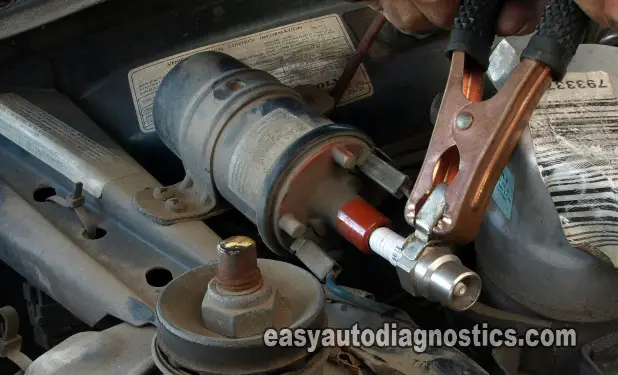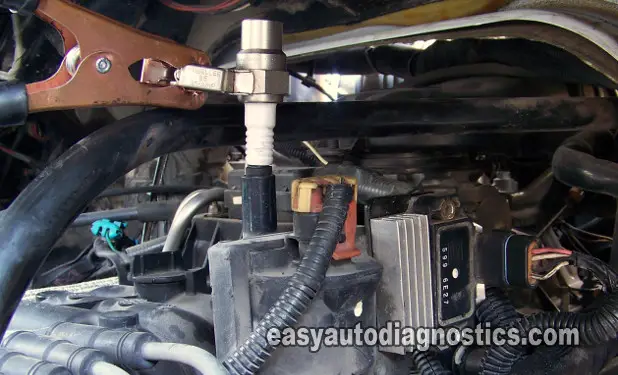The Basics Of The Ignition Coil's Secondary Circuit
The Secondary circuit consist of the Secondary coil winding within the ignition coil, the spark itself and whatever medium is used to deliver it to the spark plugs.
Examples are:
- The distributor cap.
- The distributor rotor.
- The ignition cables (spark plug wires).
- The ignition coil boot (on Coil-On-Plug systems).
The distributor-type systems and the distributor-less type systems all behave in the same basic manner. The idea behind them both is to create spark and deliver it to the individual cylinders to begin the combustion process of the gasoline injected within the cylinder.
Depending on the type of system and manufacturer, this voltage can be anywhere between 10,000 Volts and 60,000 Volts. This is why all safety precautions must be exercised to not get zapped when testing the ignition system.
Testing The Ignition Coil For Spark
Testing the Secondary system of the ignition coil is easy. You'll need a spark tester and a battery jump start cable for this test.
There are so many spark testers on the market right now and the best one (and one of the most inexpensive ones) is the HEI spark tester. This is the one I recommend you use to get a spark result you can trust.
Here's the test:
- Disconnect the high tension wire from the ignition coil tower.
- Connect one end of a battery jump start cable to a good Ground point on the engine, preferably on the battery negative (-) terminal.
- Place the HEI spark tester in the other end of the battery jump start cable.
- Holding the HEI spark tester with the jump start cable, place it directly on the ignition coil tower.
- When all is ready, have your helper crank the vehicle.
- You'll get one of two results: spark or no-spark.
If you got a spark result, then this confirms that the ignition coil is working properly. If you got a no-spark result, then the next step is to verify that the ignition coil is getting power (12 Volts) and that the ignition control module (ICM) is creating and feeding a Switching signal.
Testing for spark should be the very first thing to do when troubleshooting the ignition coil or the ignition system. If there's spark present, then you now know that the ignition coil is good.
Why Is It Important To Know This Stuff?
So why do you need to know all of this stuff? Isn't it enough just to know a couple of tests? The most important reason why is that it will help you to diagnose the ignition coil (or coils) effectively in a wide range of vehicles. Is it a Ford, a Suzuki, a Honda, or a Chevrolet vehicle? You get the idea.
What solved the problem on one vehicle will not solve the problem on another with the exact same symptom. So, going beyond just testing the ignition coils, if you know the working theory of the component you're trying to troubleshoot, you'll know what signals it has to have to do what it was designed to do. If all signals are present and yet it does not work, the component is bad. If even one signal is not present, the component will not work, and you have now eliminated it as the cause of the problem. This is the basis of all troubleshooting strategies!
Not only that, a test that you may read in a repair manual or online may not give you a specific reason as to the ‘why’ of the result you are supposed to obtain. Knowing the theory of how the component (in this case the ignition coil) works, will let you understand the ‘why’ of the result. And the ‘why’ of the next step.
Therefore, knowledge is key, and the more you research online, or in automotive technology books, the better prepared you'll be to save money, time and headaches working on your car.


